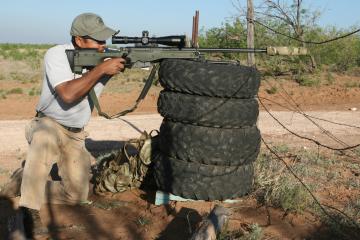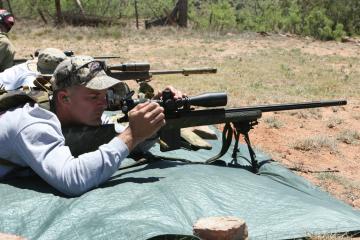Prior Steel Safari Match Reports
The 2008 Steel Safari was extra tough this year for two reasons: extreme wind and extreme heat.
With more target opportunities, shooters were put to an extremely tough mental, physical, and
marksmanship challenge. The competitor who had the skill, preparation, and luck locked down the
match title, but all those that finished were treated to a prize table better than any prior year's
match.
The Steel Safari is a non-standard contest that examines practical rifle skills, including target recognition, range estimation, wind doping, trail skills, and marksmanship. Dr. David Kahn's Keneyathlon ("hunters test") is another of this type of hunting match. However, these skills are not limited to hunting. Matches such as the Practical Rifle Team Challenge (NM), International Tactical Rifleman Championship (WY) and various Sniper Challenge matches around the country approach the same format from a practical or tactical point of view. In both cases, the crux is target location, ranging, and making first-round hits in field conditions, while moving through the natural terrain. This is worlds different from both Bench-Rest and NRA High Power Long Range.

At the 2007 match, Dave Wheeler announced it was the last year due to the labor required to set up the match. After a flurry of discussion, three shooters stepped up and offered to take over the match starting in 2008. Those three shooters were all Steel Safari veterans, and included Mike Kolar, Michael Field, and me (Zak Smith). Our feeling was that the match was too good to let die, even if it meant taking one for the team and running the match ourselves. (As match directors, we would be ineligible to shoot the match for score, since we would know all the target locations.) Thus, the 2008 Steel Safari was run under the banner of Colorado Multi-Gun (CMG). CMG was formed in late 2005, and the first major match it presented was the 2006 Practical Rifle Team Challenge.

Given a proven match format, we didn't want to make a lot of changes. However, we did want to simplify certain procedurals aspects of the match, and we wanted to increase the round count. To this end, we increased the target engagements to six at each station and we established ten shoot stations on each field course. This yielded a total of 60 engagements per field course, or 120 for the entire match. In addition, to ensure parity with regard to weather conditions on the two match days, we equalized the mix of short and long-range targets on each course. The average target distance on the North and South courses were within five yards of the same distance -- about 350 yards.

Due in part to the photos I took at the Blue Steel Ranch during practice and prior Steel Safari matches, demand for this match was high. This was the first year any advertising was done for the match, and excitement on internet forums like SnipersHide was high. The match filled to its 30-shooter limit within about ten days. Ultimately, everyone on the wait list got an opportunity to register for the match due to some last-minute cancellations due to the price of fuel and travel. In all, there were 27 competitors including representatives from Surefire, CS Gunworks, Newman Precision, Thunder Beast Arms, Big American Man, and J.Dustin/Legacy Sports. Due to lack of interest, the "Light Rifle" category was cancelled, and shooters used a variety of rfles from 6XC/.243 Winchester up to .300 Winchester Magnum. |